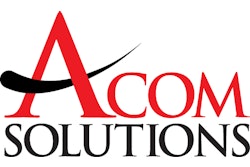ERP players made gains in '03, but CIO-CPO tug of war will keep market fragmented, AMR reports
Boston — September 17, 2004 — The market for sourcing and procurement solutions barely edged ahead in 2003, largely on the backs of the top enterprise resource planning (ERP) solution providers and on increased demand for services, but the market is set to rebound in 2004 and through 2008, according to a new research alert from technology consultancy AMR Research.
In the alert, "Sourcing and Procurement Market Roundup for 2003-2008," co-authors Pierre Mitchell and Janet Suleski write that after hitting "rock bottom" in 2002, the procurement and sourcing market managed to eke out 2 percent growth in 2003.
Much of the growth could be attributed to the top-three ERP vendors, which saw 16 percent revenue growth, and to increasing demand for such services as low-cost country sourcing, compliance management, supplier management, analytics, benchmarking and data management services, according to AMR. "This has primed the pump for 5 percent growth in 2004 and 8 percent market growth from 2003-2008," Mitchell and Suleski write.
The analysts note that with purchased spending accounting for about half of a company's total outlays, the imperatives to cut costs and accelerate savings mean that purchasing organizations necessarily are challenged by such issues as the need for more global supply management, the requirement to meet high savings targets despite a weak dollar and rising prices for many commodities, and the opportunities for increased outsourcing of non-core processes.
With regard to purchasing and sourcing technology, AMR warns that software will not be sufficient for meeting the purchasing department's goals. "Procurement excellence requires more than better process automation," the consultancy writes in the report. Mitchell and Suleski go on to suggest the ongoing consolidation among software and service players in the procurement and sourcing space highlights the fact that "people and processes are just as important" as technology in meeting purchasing's goals.
However, in spite of the recent mergers and acquisitions of some smaller players in this space, a tug of war between chief information officers and chief procurement officers will likely keep the market fragmented for the next three to five years, they predict.
"The CIO wants to minimize the number of vendors (and maximize a large ERP investment), while the CPO wants to maximum speed-to-savings and speed-to-transformation, without much regard to historical IT investments," Mitchell and Suleski write. "As such, the top-three ERP vendors selling to the CIO grew their license revenue by a whopping 51 percent, but their incomplete functionality (and professional services capabilities) in areas such as e-sourcing, services procurement and contract management have allowed specialist vendors ... to enjoy some success in these niches."
In offering recommendations for technology users, the analysts suggest that they not allow the lack of functionality in their ERP systems hold up their efforts to reap the benefits of better supply management. Instead, they write, companies should look to "specialty vendors" in the short term to achieve savings while "laying the groundwork for longer-term ERP support" in specific areas of functionality.
Pierre Mitchell is a vice president for research at AMR, and Janet Suleski is a senior research analyst with the firm. More information on the sourcing and procurement market is available in AMR's study "Procurement and Sourcing Applications Report, 2003-2008."
For more information on the current state of the sourcing and procurement markets, see the articles "The Analyst Corner: Sourcing" in the June/July 2004 issue of Supply & Demand Chain Executive, and "The Analyst Corner: Procurement" in the August/September 2004 issue of the magazine.
Boston — September 17, 2004 — The market for sourcing and procurement solutions barely edged ahead in 2003, largely on the backs of the top enterprise resource planning (ERP) solution providers and on increased demand for services, but the market is set to rebound in 2004 and through 2008, according to a new research alert from technology consultancy AMR Research.
In the alert, "Sourcing and Procurement Market Roundup for 2003-2008," co-authors Pierre Mitchell and Janet Suleski write that after hitting "rock bottom" in 2002, the procurement and sourcing market managed to eke out 2 percent growth in 2003.
Much of the growth could be attributed to the top-three ERP vendors, which saw 16 percent revenue growth, and to increasing demand for such services as low-cost country sourcing, compliance management, supplier management, analytics, benchmarking and data management services, according to AMR. "This has primed the pump for 5 percent growth in 2004 and 8 percent market growth from 2003-2008," Mitchell and Suleski write.
The analysts note that with purchased spending accounting for about half of a company's total outlays, the imperatives to cut costs and accelerate savings mean that purchasing organizations necessarily are challenged by such issues as the need for more global supply management, the requirement to meet high savings targets despite a weak dollar and rising prices for many commodities, and the opportunities for increased outsourcing of non-core processes.
With regard to purchasing and sourcing technology, AMR warns that software will not be sufficient for meeting the purchasing department's goals. "Procurement excellence requires more than better process automation," the consultancy writes in the report. Mitchell and Suleski go on to suggest the ongoing consolidation among software and service players in the procurement and sourcing space highlights the fact that "people and processes are just as important" as technology in meeting purchasing's goals.
However, in spite of the recent mergers and acquisitions of some smaller players in this space, a tug of war between chief information officers and chief procurement officers will likely keep the market fragmented for the next three to five years, they predict.
"The CIO wants to minimize the number of vendors (and maximize a large ERP investment), while the CPO wants to maximum speed-to-savings and speed-to-transformation, without much regard to historical IT investments," Mitchell and Suleski write. "As such, the top-three ERP vendors selling to the CIO grew their license revenue by a whopping 51 percent, but their incomplete functionality (and professional services capabilities) in areas such as e-sourcing, services procurement and contract management have allowed specialist vendors ... to enjoy some success in these niches."
In offering recommendations for technology users, the analysts suggest that they not allow the lack of functionality in their ERP systems hold up their efforts to reap the benefits of better supply management. Instead, they write, companies should look to "specialty vendors" in the short term to achieve savings while "laying the groundwork for longer-term ERP support" in specific areas of functionality.
Pierre Mitchell is a vice president for research at AMR, and Janet Suleski is a senior research analyst with the firm. More information on the sourcing and procurement market is available in AMR's study "Procurement and Sourcing Applications Report, 2003-2008."
For more information on the current state of the sourcing and procurement markets, see the articles "The Analyst Corner: Sourcing" in the June/July 2004 issue of Supply & Demand Chain Executive, and "The Analyst Corner: Procurement" in the August/September 2004 issue of the magazine.








